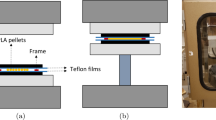Abstract
Core–shell structured polyacrylic (named ACR) impact modifiers consisting of a rubbery poly(n-butyl acrylate) (BA) core and a rigid poly(methyl methacrylate) shell with a size of about 310 nm were prepared by seed emulsion polymerization. The ACR modifiers with different core–shell weight ratios (85:15; 80:20; 75:25; 70:30) were used to modify the toughness of poly(butylene terephthalate) (PBT) by melt blending. It was found that the polymerization had a very high instantaneous conversion (>90 %) and overall conversion (98 %). The ACR latexes had an obvious core–shell structure confirmed by transmission electron microscope. The mechanical properties of the PBT/ACR blends were evaluated, and scanning electron microscope (SEM) was used to observe the fractured morphology. Dynamic mechanical analysis and differential scanning calorimeter were used to study the molecular movement and crystallization behaviors of PBT/ACR blends. The results indicated that with an appropriate value of the core–shell weight ratio, poly(BA) could disperse well in the matrix and the brittle–ductile transition point could emerge. As a result, the notch impact strength of PBT/ACR blends with a core–shell weight ratio of 80:20 was 6.7 times greater than that of pure PBT, and the mechanical properties agreed well with the SEM observation.







Similar content being viewed by others
References
Canto LB, Hage E Jr, Pessan LA (2006) Effects of the molecular structure of impact modifier and compatibilizer on the toughening of PBT/SBS/PS-GMA blends. J Appl Polym Sci 102:5795–5807
Su JJ, Peng F, Gao X, Yang GH, Fu Q, Wang K (2014) Superior toughness obtained via tuning the compatibility of poly(ethylene terephthalate)/poly(ethylene-octene) blends. Mater Des 53:673–680
Sun S, Tan Z, Zhou C, Zhang M, Zhang H (2007) Effect of ABS grafting degree and compatibilization on the properties of PBT/ABS blends. Polym Compos 28:484–492
Dayma N, Satapathy BK (2010) Morphological interpretations and micromechanical properties of polyamide-6/polypropylene-grafted-maleic anhydride/nanoclay ternary nanocomposites. Mater Des 31:4693–4703
Hale WJ, Keskkula H, Paul DR (1999) Compatibilization of PBT/ABS blends by methyl methacrylate-glycidyl methacrylate-ethyl acrylate terpolymers. Polymer 40:365–377
Aróstegi A, Nazábal J (2003) Super toughness and critical interparticle distance dependence in poly(butylene terephthalate) and poly(ethylene-co-glycidyl methacrylate) blends. J Polym Sci B Polym Phys 41:2236–2247
Aróstegi A, Nazábal J (2003) Critical inter-particle distance dependence and super-toughness in poly(butylene terephthalate)/grafted poly(ethylene-octene) copolymer blends by means of polyacrylate addition. Polymer 44:5227–5237
Collyer AA (1994) Rubber toughened engineering plastics. Chapman and Hall, London
Ito EN, Pessan LA, Covas JA, Hage E (2003) Analysis of the morphological development of PBT/ABS blends during the twin screw extrusion and injection molding processes. Int Polym Process 18:376–381
Lazzeri A, Bucknall CB (1993) Dilatational bands in rubber-toughened polymers. J Mater Sci 28:6799–6808
Kim GM, Michler GH (1998) Micromechanical deformation processes in toughened and particle filled semicrystalline polymers: Part 2. Model representation for micromechanical deformation processes. Polymer 39:5699–5703
Dobler F, Pith T, Lambla M, Holl Y, Col J (1992) Coalescence mechanisms of polymer colloids I. Coalescence under the influence of particle-water interfacial tension. J Colloid Interface Sci 152:1–11
Sommer F, Duc TM, Pirri R, Meunier, Quet C (1995) Surface morphology of poly(butyl acrylate)/poly(methyl methacrylate) core–shell latex by atomic force microscopy. Langmuir 11:440–448
Chia FL, Kuen RI, Wen YC (1994) Kinetics studies of two-stage soapless emulsion polymerization of butyl acrylate and methyl methacrylate. J Appl Polym Sci 51:1621–1628
Qu XW, Wang NY, Lovell PA (2009) Preparation and characterization of the latexes with different particle sizes by semibatch emulsion polymerization and the influence on properties of waterborne pressure-sensitive adhesives. J Appl Polym Sci 112:3030–3040
Ovando-Medina et al (2013) Semicontinuous heterophase copolymerization of vinyl acetate and butyl acrylate. J Appl Polym Sci 127(4):2458–2464
Larocca NM, JrE Hage, Pessan LA (2005) Effect of reactive compatibilization on the properties of poly(butylene terephthalate)/acrylonitrile–ethylene–propylene–diene–styrene blends. J Polym Sci B Polym Phys 43:1244–1259
Chiou KC, Chang FC (2000) Reactive compatibilization of polyamide-6 (PA6)/polybutylene terephthalate (PBT) blends by a multifunctional epoxy resin. J Polym Sci B Polym Phys 38:23–33
Aróstegui A, Gaztelumendi M, Nazábal J (2001) Toughened poly(butylene terephthalate) by blending with a metallocenic poly(ethylene-octene) copolymer. Polymer 42:9565–9574
Aróstegui A, Nazábal J (2002) Stiffer and supertough poly(butylene terephthalate) based blends by modificated with phenoxy and maleated poly(ethylene-octene) copolymers. Polymer 44:239–249
Paul S, Kale DD (2000) Impact modification of polypropylene copolymer with a polyolefinic elastomer. J Appl Polym Sci 76:1480–1484
Aróstegui A, Nazábal J (2004) Compatibilization of a poly(butylene terephthalate)/poly(ethylene octene) copolymer blends with different amounts of an epoxy resin. J Appl Polym Sci 91:260–269
Guo TY, T Styrene ang GL, Hao GJ, Song MD, Zhang BH (2003) Toughening modification of PS with n-BA/MMA/core-shell structured copolymer from emulsifier-free emulsion polymerization. J Appl Polym Sci 90:1290–1297
Wu GF, Zhao JF, Shi HT, Zhang HX (2004) The influence of core-shell structured modifiers on the toughness of poly(vinyl choride). Eur Polym J 40:2451–2456
Acknowledgments
This work was partially supported by Natural Science Foundation of Hebei Province; contract grant number: E2010000107, and National Natural Science Foundation of China; contract grant number: 51073049 and 21001039. The authors would like to thank Professor Maryam Grami, Winona State University, MN, USA, for her helpful discussions during revision.
Author information
Authors and Affiliations
Corresponding authors
Rights and permissions
About this article
Cite this article
Yang, Y., Li, G., Yu, X. et al. Toughening of poly(butylene terephthalate) by polyacrylic impact modifier. Polym. Bull. 71, 2353–2367 (2014). https://doi.org/10.1007/s00289-014-1192-4
Received:
Revised:
Accepted:
Published:
Issue Date:
DOI: https://doi.org/10.1007/s00289-014-1192-4




